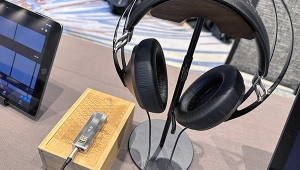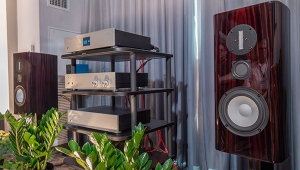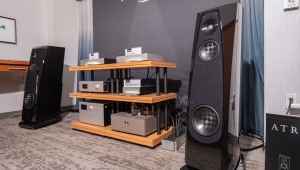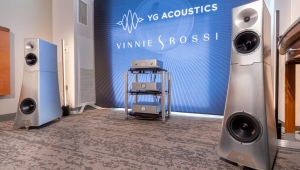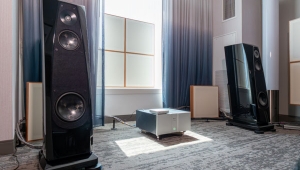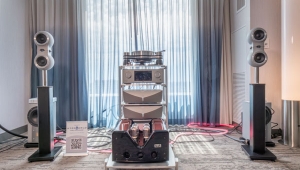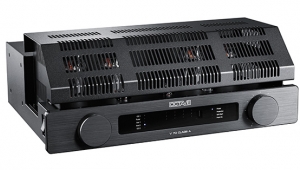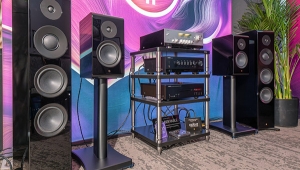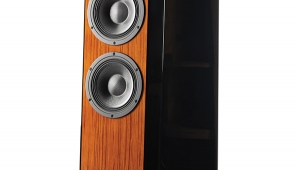| Columns Retired Columns & Blogs |
Linn Karik/Numerik CD player 1994 Measurements part 2
Fig.8 is the Numerik's frequency response and de-emphasis error. The processor rolls off half a dB at 20kHz, and the de-emphasis circuit has a 0.3dB positive error in the treble. The result will be a slight brightening of the sound when playing those rare discs recorded with emphasis. Crosstalk performance (fig.9) was excellent, with 100dB of channel separation at 1kHz, and holding to better than 100dB at any audio frequency.

Fig.8 Linn Numerik, frequency response (top) and de-emphasis error (bottom) (right channel dashed, 0.5dB/vertical div.).

Fig.9 Linn Numerik, crosstalk (right-left dashed, 10dB/vertical div.).
A spectral analysis of the Numerik's output when decoding a -90dB 1kHz dithered sinewave (fig.10) showed the processor to have good linearity, a low noise-floor, and no intrusion of power-supply noise on the audio signal. A benefit of switching power supplies is the lack of noise components in the audioband at 60Hz and its harmonics.
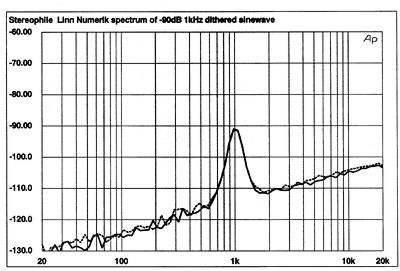
Fig.10 Linn Numerik, spectrum of dithered 1kHz tone at -90.31dBFS, with noise and spuriae (1/3-octave analysis, right channel dashed).
Fig.11 compares the linearity performance of the Numerik with the PCM63 DACs with that of the Numerik fitted with the new PCM1702 DACs. The 1702's linearity, shown in the upper pair of traces, has been offset by 4dB so that it can appear on the same graph. The PCM63 has marginally better linearity than the 1702—at least in the individual DACs found in the review samples. Fig.12 shows the Numerik's reproduction of a -90dB, 1kHz undithered sinewave. This is excellent shape: the three digital levels (0, +1, -1) are clearly delineated, and the noise level is low. The noise-modulation plots (fig.13) show good, but not superlative, performance. There's some deviation between traces—even above 1kHz, where they normally converge.
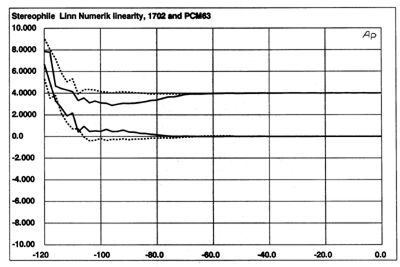
Fig.11 Linn Numerik, departure from linearity: PCM1702 DAC (top, offset by 4dB); PCM63 DAC (bottom) (2dB/vertical div.).

Fig.12 Linn Numerik with PCM 1702 DAC, waveform of undithered 1kHz sinewave at -90.31dBFS.

Fig.13 Linn Numerik with PCM 1702 DAC, noise modulation, -60 to -100dBFS (10dB/vertical div.).
The Numerik's intermodulation performance (fig.14) was superb, with the 1kHz difference product below -100dB, and no other IM products exceeding the -100dB level. The intermodulation spectrum produced by the Numerik with the PCM63 DACs was nearly identical.

Fig.14 Linn Numerik with PCM 1702 DAC, HF intermodulation spectrum, DC-22kHz, 19+20kHz at 0dBFS (linear frequency scale, 20dB/vertical div.).
Finally, I measured the Numerik's word-clock jitter using the Meitner LIM Detector. The jitter spectra, shown in figs.15 and 16, were made with an input signal of a full-scale, 1kHz sinewave and with a -90dB, 1kHz sinewave, respectively. The spectrum in fig.15 is moderately clean, with some periodic jitter components visible. Unusually, the jitter spectrum with a very-low-level signal (-90dBFS) shows a lower number of periodic jitter components. (A low digital signal level creates more bit transitions, which introduce more jitter in the interface.) The RMS jitter levels, measured over a 400Hz-22kHz bandwidth, were 62 picoseconds with both test signals. This is excellent jitter performance.—Robert Harley

Fig.15 Linn Numerik, word-clock jitter spectrum, DC-20kHz, when processing 1kHz sinewave at 0dBFS (linear frequency scale, 10dB/vertical div., 0dB=1ns).

Fig.16 Linn Numerik, word-clock jitter spectrum, DC-20kHz, when processing 1kHz sinewave at -90dBFS (linear frequency scale, 10dB/vertical div.
- Log in or register to post comments
















